Note: In the following sections, vehicles can be cars, trucks, planes, or ships. Where variations from the process occur, they are detailed at each step.
When planning inbound movements of freight (i.e. receiving a consignment):
Preparing for reception
The sender must always inform the consignee ahead of shipping goods, sharing as much information as possible on the shipment before the vehicles leave for delivery.
Information to share ahead of shipping:
- expected arrival date and time
- goods transported: a draft packing list or reference to orders (requisition), estimated weights and volumes
- vehicle details: registration, driver/pilot details and route. For sea shipments, this will be vessel route and shipping line
- special requirements: cold chain, dangerous goods, bulky equipment, etc.
- details of vehicles: schedule, number of trips and prioritisation.
The receiver should confirm their capacity to handle the inbound shipment and make necessary arrangements.
Arrange your reception area to ensure the full consignment can be temporarily stored before being moved into the bulk storage area – if necessary, make temporary adjustments to the warehouse layout to accommodate the incoming consignment.
Communicate temporary changes to the layout to the warehouse team.
To prepare for reception:
- plan for space to offload
- plan for documentation to track offloading process – ensure a detailed packing list is available
- plan for available manpower to offload
- plan for cold chain capacity if needed
- re-schedule planned orders with the warehouse team and end users
- prepare labels for storage
- rent or procure handling equipment if necessary
- prioritise processing order with end users.
Information to share after shipping:
- container seal number where relevant
- expected ETA
- copy of final transport document (waybill, bill of lading, air waybill, CMR where relevant)
- exact contents of consignment: final packing list, weights & dimensions, specific handling requirements and markings
- contact details of driver/pilot and rental company (if relevant).
The captain of a vessel can usually not be contacted directly, but vessels can be tracked by a bill of lading.
Note: where the shipper of the goods is the supplier of the same goods, the same details must be obtained from them.
| Sharing shipment details | Provided by | |
|---|---|---|
| Responsible | Shipper | Receiver |
| Accountable | Receiver | Receiver |
| Consulted | Receiver/requestor | Requestor |
| Informed | Requestor | Shipper |
At the time of reception
| When to count containers | When to count pallets | When to count boxes | When to count boxes' contents |
|
|---|---|---|---|---|
| Air | N/A | At airport if palletised | At airport if unpalletised At delivery place if palletised | At delivery place |
| Sea | At port | At port if possible At delivery place otherwise | At port if possible and unpalletised At delivery place if palletised | At delivery place |
| Road | At delivery place if relevant | At delivery place if relevant | At delivery place | At delivery place |
| Rail | At delivery place if relevant | At delivery place if relevant | At delivery place if relevant | At delivery place |
Available to download here.
Note: counting the contents of sea freight containers (pallets, boxes, loose goods, etc) can often not be done at the port and has to be done either at the final delivery place or at the freight forwarders/clearing agent’s premises.
Road consignments will usually be delivered straight to the delivery point. At the time of offloading, make sure every unit (pallet or box) is accounted for, and store them separately until the entire content of the boxes has been reviewed against the shipping documents accompanying the truck. Where a transhipment is needed, all pallets and boxes must be accounted for during the transhipment.
At time of reception:
- Check that all documents are attached to the consignment: commercial invoice, gift certificate, packing list, waybill, bill of lading, air waybill or CMR sheet (where applicable) and any customs clearance certificate (including tax waiver documents where applicable).
- Check that container seals are in good condition.
- Check the condition of each box/pallet as it is offloaded and check for labels.
- Confirm number of boxes matches the consignment documentation in each vehicle/container.
- Check and inspect the contents of each box to confirm exact quantities received against the packing list attached to the consignment.
Record any discrepancy and reconcile only once all boxes have been inspected (sometimes all ordered goods are in the consignment, but the packing lists are not accurately broken down per packaging unit). - If receiving a cold chain consignment, read the temperature-monitoring devices attached to the consignment, to confirm cold chain has been maintained throughout the transport process.
Offloading trucks
If available, use loading docks or platforms. Otherwise, position the truck on level, solid ground, as close as you can to where the goods must go to.
Allow enough space for movement around the truck, especially if you are using a forklift truck or hand pallet truck.
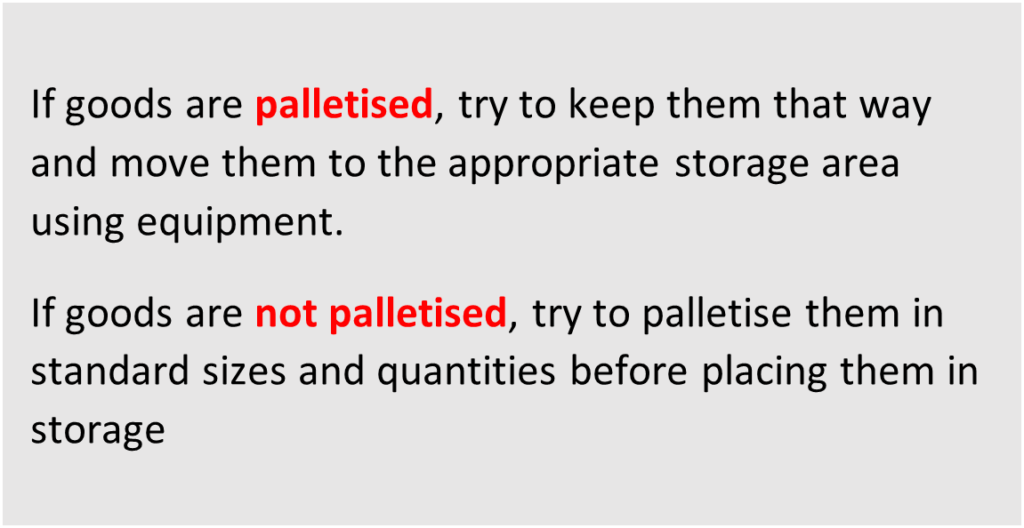
If you have inbound trucks and outbound trucks available simultaneously, consider whether it is worth trans-shipping directly from one truck to the other (as long as you can control the process and ensure accurate counting is done).
If handling equipment is not available, do not throw unidentified goods from a truck but hand them down carefully.
If goods must be manually handled because there is no handling equipment, use a chain of people (with one person in charge). The chain must have enough people for each person not to have to ‘walk’ more than one step. The people should be placed facing alternately along the chain to avoid unnecessary ‘twisting’.
View an example diagram of correct offloading of trucks here.
Avoid handling goods more times than you must by only putting them down where they have to go, in the stack they have to go in (see the Storage options section of Setting up a warehouse for more information on stacking). If the person you are handing the goods to is not ready, call the chain to stop.
Always maintain height if you can. Do not put goods on the floor if they must be lifted up again.
Make sure someone who is not handling the goods is counting as the goods are moved. That person should keep a tally (marking off per layer removed or built, for example), in case they get interrupted and cannot remember where they had counted to.
A check count should be done when each stack is created.
When all goods are offloaded, cross-check offloaded quantities against shipping documents and make note of any discrepancy.
Remember to take breaks when needed during offloading and make sure drinking water is readily available.
Documenting the reception
For details on how to receive goods in a warehouse, see the Receiving stock, Document the reception, Receiving stock for the British Red Cross (in UK or at Regional Logistics Units) and Releasing stock sections of the Warehousing chapter.
After reception of the goods
Record all received quantities on the appropriate stock cards and bin cards, referring to the GRN/ as appropriate.
Transfer the goods from the reception area to the main storage area as soon as possible.
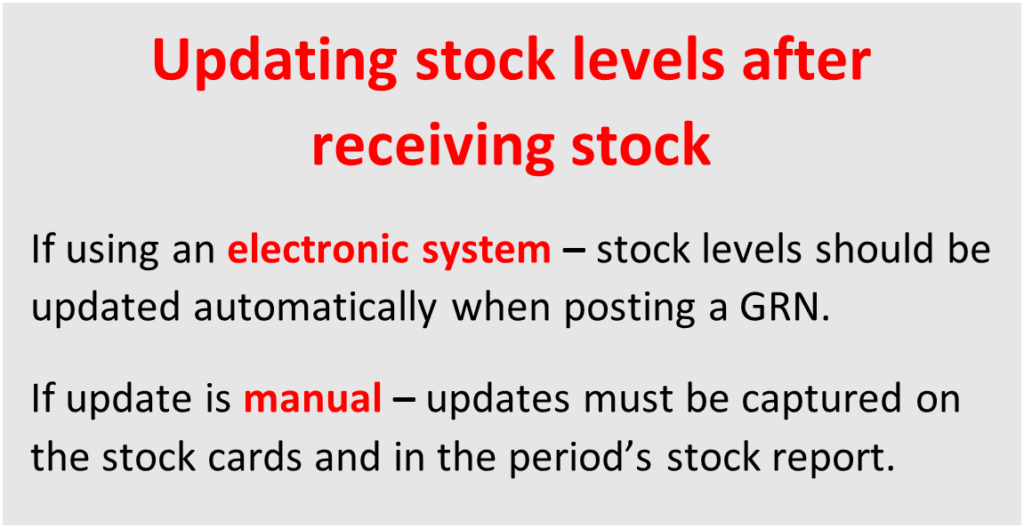
In case of any claims, follow up on resolution options with the sender/transporter, agreeing on corrective measures to be put in place for future shipments where relevant.
Log the shipment in a shipment tracker, with complete details of the consignment – this will be used in the activity reporting process.
Inform the requestor and sender of completed delivery: share a copy of the GRN. Detail any measures being taken to address claims and raise (where applicable).
For more details on the reception of international cargo, refer to the Warehousing chapter.
Preparing outbound shipments
When planning outbound movements of freight (i.e. shipping a consignment):
The sender must always inform consignee ahead of shipping goods, sharing as much information as possible on the shipment before the vehicles leave for delivery.
Information to share ahead of shipping:
- expected arrival date and time
- special requirements: cold chain, dangerous goods, bulky equipment, etc.
- goods transported: a draft packing list or reference to orders (requisition), estimated weights and volumes
- details of vehicles: schedule, number of trips and prioritisation
- vehicle details: registration, driver/pilot details and route. For sea shipments, this will be vessel route and shipping line.
Move the goods to be shipped to a designated dispatch area. The dispatch area can be temporarily modified as necessary, but make sure the warehouse team is informed of any changes.
Inspect the goods to be shipped: are all packaging units in good condition? Ensure cartons/pallets are stripped of any markings that could lead to confusion.
What are the packaging/labelling requirements? Be sure to ask the transporter and the consignee about any specific requirement they may have. Shipping instructions will also be helpful to find information about such requirements.
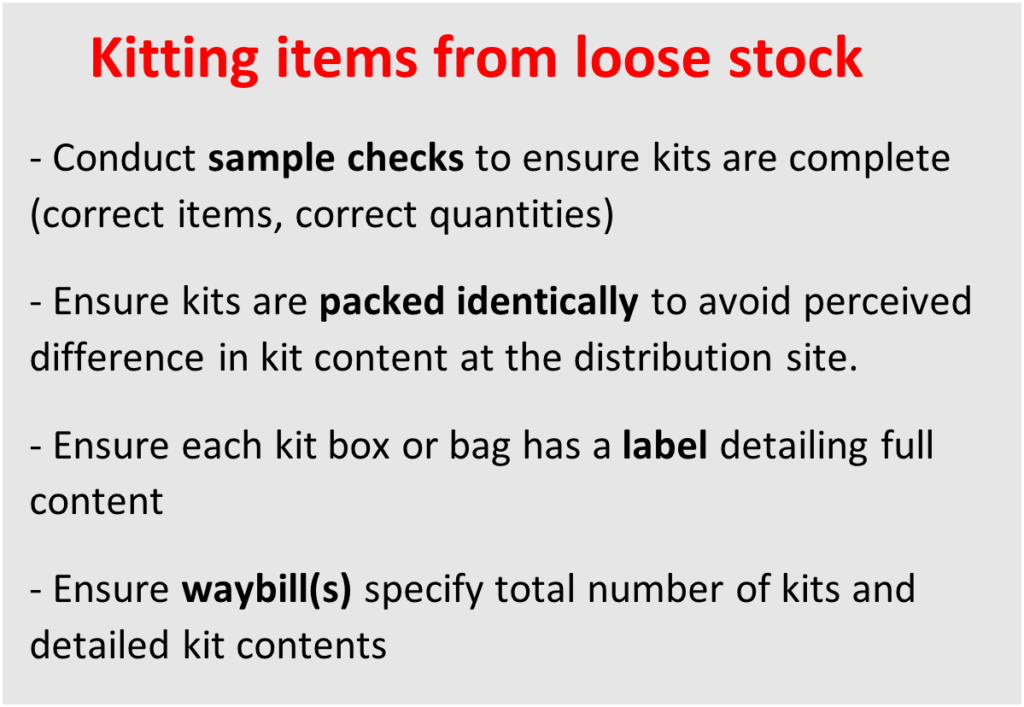
What will be the route of the vehicle, and the shipping mode? This will impact the loading plan and must be agreed with the transporter as early as possible. When sending sea shipments, control over the loading plan will be with the shipping line.
Where temperature control is required, cold chain materials (thermometer, temperature tracking devices, cool boxes, icepacks, etc.) must be made available.
Raise a final packing list with all details of the consignment. In the Red Cross movement, the waybill is often used as a packing list however it is sometimes easier to use both documents separately (for very large consignments for example).
Use a load optimisation tool to determine best transport options (this only works for road shipments).
Place the request for the necessary vehicles well in advance (as per the terms of the service-level agreement defined in the contract, where relevant), ensuring that you receive driver/pilot details and a vehicle registration certificate before the shipping date.
Ensure the necessary manpower and loading equipment will be available for loading the vehicles.
When using shipping containers, make sure the use of the containers is optimised and suggest changes in quantities where relevant (e.g., when five per cent of the order does not fit into a single container, the consignee might be willing to postpone the delivery to save the cost of the extra container).
Based on the number of packaging units shipped, prepare a loading sheet to give to the loaders, so they can track the progress of the loading process.
Where multiple vehicles are transporting multiple items, agree in advance the load composition (i.e. whether each vehicle holds a combination of all the items or only one type of item).
Loading trucks
- If available, use loading docks or platforms. Otherwise, position the truck on level, solid ground as close as you can to where the goods have to go to or come from.
- Allow enough space for movement around the truck, especially if you are using a forklift or hand pallet truck.
- If handling equipment is not available, do not throw unidentified goods from a truck but hand them down carefully.
- When loading trucks, always stack goods starting at the front of the truck and work towards the back.
- Always place the heaviest goods on the floor of the vehicle.
- Rules about stacking also apply on a truck (see the Storage options section of Setting up a warehouse).
- If you are loading a truck for distribution, lay the goods along the length of the vehicle, so that complete sets of whatever is being delivered can be distributed off the back of the truck (unless the truck has an open top or can be easily accessed from the sides, like a ‘wing’ truck).
View an example diagram of a truck loaded for direct distribution here.
At the time of dispatching
- Hand out loading sheets to loaders and retrieve them after the vehicle is loaded.
The loading sheet should simply list all the parcels to be loaded, and one loader should monitor loading progress by ticking the parcels off as they are loaded on the truck. - Confirm the route of the vehicle.
- Raise a waybill, detailing the quantity of units (pallets, sacks, boxes) loaded, weight and volume per unit and total weight and volume of the consignment.
Alternatively, waybills can detail the total quantity, weight and volume per item included in the consignment (in particular when goods are sent unpalletized or loose). - Place seals on containers where necessary.
- Ensure load is safe (with no risk of spillage or cross-contamination, etc) and securely fastened inside the vehicle – straps can be used, or blankets can be used to secure a load on a half-empty truck, for example.
- When sending a cold chain shipment, double check the cold chain plan and ensure that clear instructions are given to the transporter.
The shipper and the driver must sign the waybill and one copy must stay at the origin.
Documenting the consignment
- The transporter will leave with three copies of the waybill.
- Certain countries or regions will require the shipper to obtain a permit to access certain areas – make sure you request such permits from the relevant authorities.
- Keep a copy of the outbound waybill, to be reconciled with the returned signed copy after reception is confirmed by the receiver.
- Where delivery is planned directly at a usage point (a distribution point where no stocks are managed, for example), a GRN will have to be raised.
The delivery will not always happen at a warehouse, so a logistician should go to the delivery site and conduct the check of the delivered items and raise the GRN with the requestor of the goods.
Where goods are missing or damaged, the GRN will be returned with a filled-out claims form.
It is safer to ensure that drivers/pilots are issued with a mission order, confirming that they are moving humanitarian goods. A standard mission order should be available in each delegation/mission/project.
After dispatch
- Log the shipment in a shipment tracker, with details of the consignment. This will be used in the activity reporting process.
- Update your stock cards and bin cards (where relevant).
- Inform the receiver of revised expected time of arrival and confirm the transporter’s contact details.
- After receiving the returned signed copy of the waybill and GRN, where claims have been raised, make sure they are addressed, and that a corrective plan is in place to avoid future disruptions.
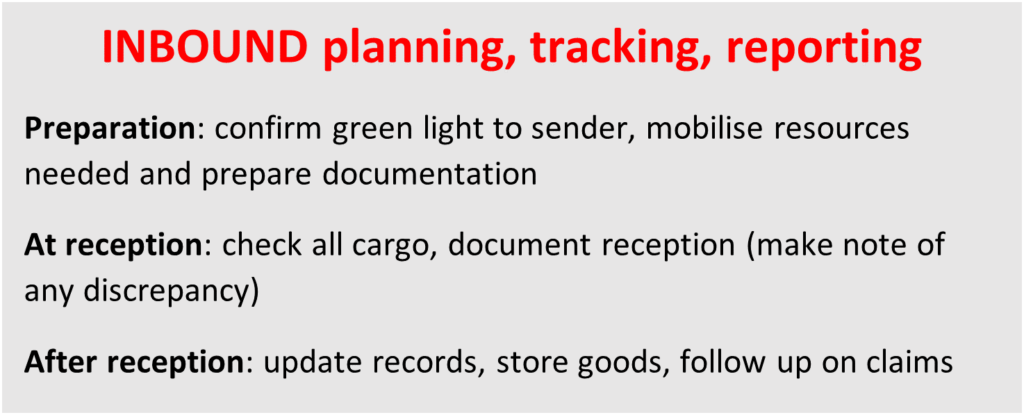
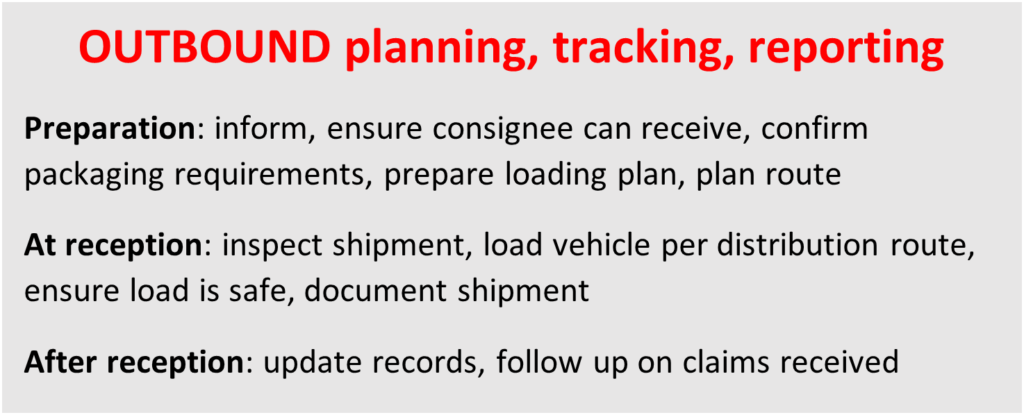
Read the next section on Shipping instructions here.
Related resources
Download useful tools and templates

